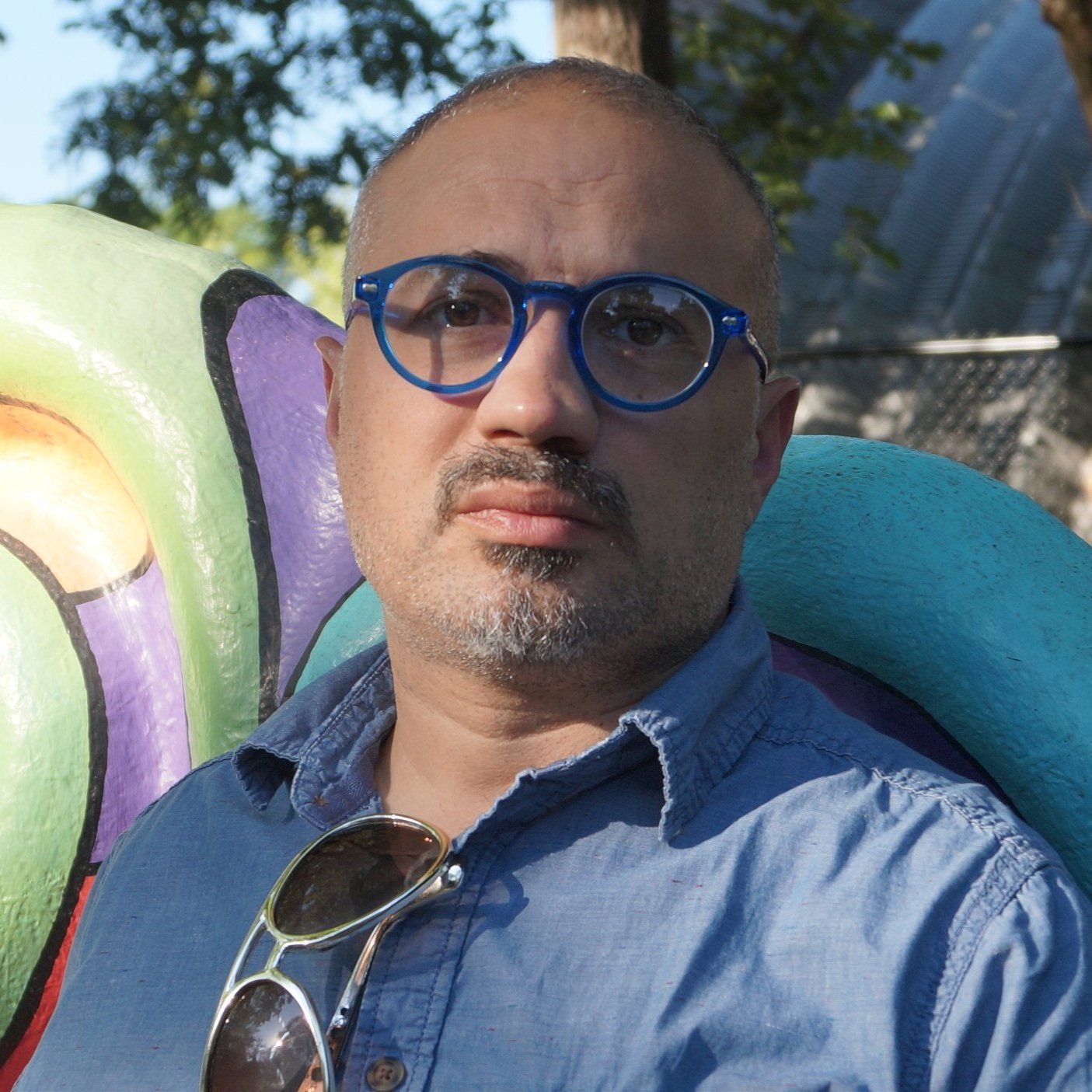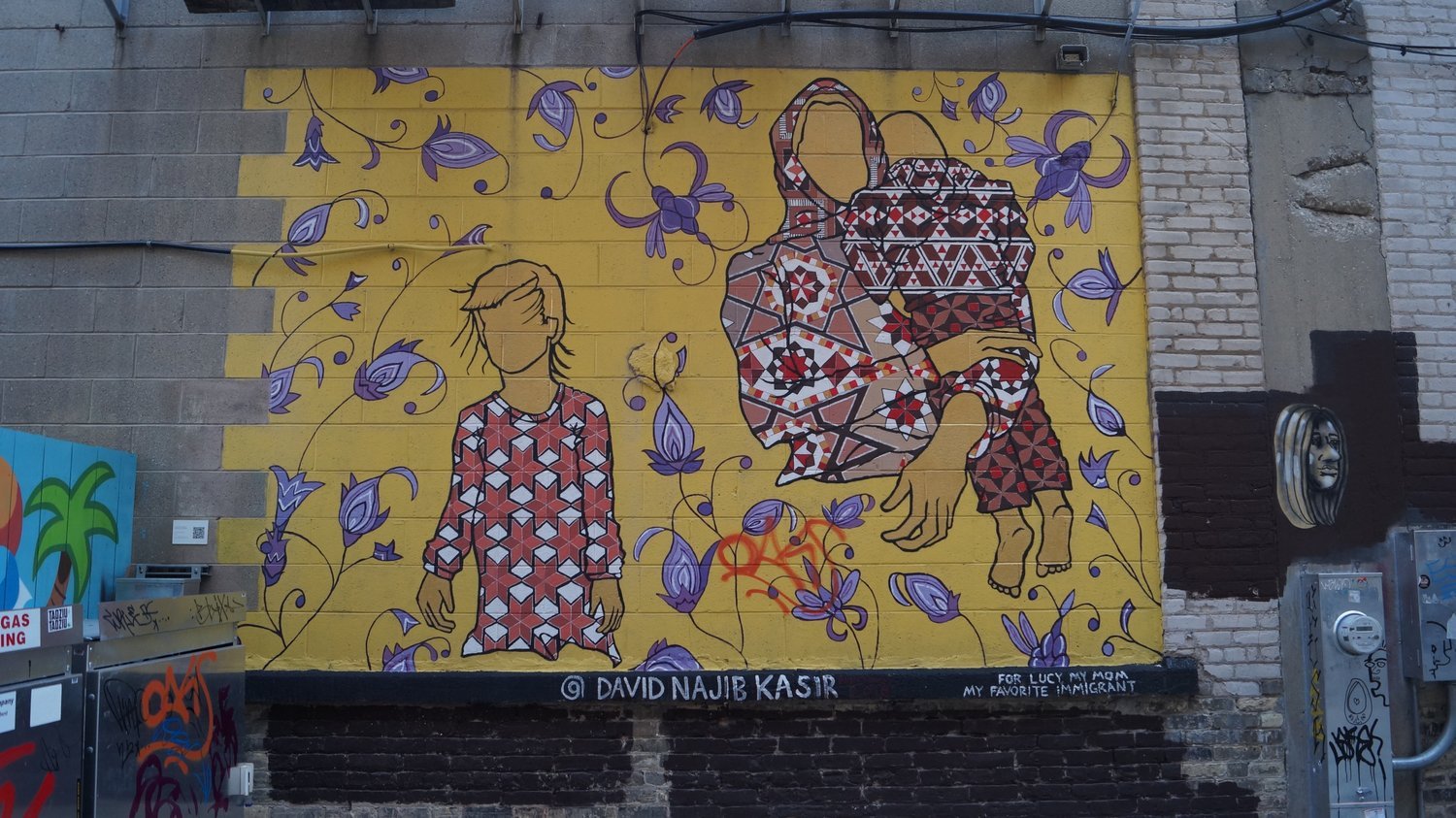David Najib Kasir
Changing the Narrative
About Arabs
“Fatherhood has really […] been the most important thing to me as an artist. I worked in art, but I don’t know if I was an artist before I became a father.”
Meet David. David Najib Kasir is an artist who challenges stereotypes about Arabs. He works in oil paint and has drawn inspiration from a form of Middle Eastern tile art called Zellige [pronounced zuh-LEEJ]. He has also adapted his work into mural-scale projects in Milwaukee and other U.S. cities. Currently working out of studio space in Var Gallery in Milwaukee’s Walker’s Point neighborhood, David is involved in WaterMarks as one of the artists invited to create art for the Beerline Trail serving Riverwest and Harambee.
Originally from Chicago, David moved to Milwaukee to study at MIAD, the Milwaukee Institute of Art and Design. His work is informed by his relationship to family, country, and world. David’s mother is from Syria, his father was Iraqi, and he identifies as an Arab American. The Syrian civil war weighs heavily upon David, and one theme running through his artwork is the trauma and humanity of people impacted by this war, with his art expressing a universal empathy for refugees and displaced peoples.
When David visited family in Syria in 1999, he came upon Zellige. He saw the distinctively Arabic geometric mosaic tile patterns in wooden inlays, game boards, instruments, jewelry boxes. It stayed with him. “They were really striking and intricate and just beautiful. I knew at that time at a young age that I wanted to somehow use those designs in my work, but at that time I just had no reason to. I was still a student,” David says, and this was before the 9/11/2001 terrorist attacks and the increased American military presence in the Middle East that followed. “It wasn’t until the Syrian civil war that I decided I would use that as part of the language in creating awareness of the civil war.”
Zellige patterns appear in a variety of David’s artwork, both subtly as an accent or as a primary element. It is one way he celebrates the rich cultural heritage and contributions of the Arabic world.
Challenging stereotypes about Arabs through his art is one of David’s intentions. “We’ve always been depicted as the bad guys in movies and stories and media and the news,” he says. “That has been the wrong narrative.”
In several series of his artwork, David presents figures drawn or outlined with blank features and faces. The effect is to create a certain universality that invites the viewer to step into and fill in the blanks—associating or empathizing with the characters presented. David explains that his choice was also to render the figures without colored skin tones that could otherize them from white audiences. “I wanted white people to put their own faces in there and I thought if I were to put anything of color on there they’d dismiss it easily,” David says.
David’s mural in Milwaukee’s Black Cat Alley is an example. It shows a child facing the viewer beside a mother character whose head is wrapped in cloth and who holds a younger child on her shoulder. The figures’ clothing is stylized with different geometric patterns that suggest their individuality, but their faces are left blank. Except for the youngest child, they are also presented without lower torsos, as though appearing ghostlike from the yellow background that is just a shade lighter than their skin. With an economy of design elements, David’s mural presents a haunting scene suggesting a family’s loss and displacement. Strings of purple flowers braid throughout the scene as though to suggest a unifying vitality from a natural world containing a fragile beauty that still exists—if perhaps just beyond the frame of the characters’ unwritten story. The piece at once invites intimacy with this family shown without a father, but also suggests the daunting universality of pain.
As he considers his approach to the WaterMarks public art opportunity, David is drawn to how water is often a defining element of the refugee experience. Water scarcity can create refugees fleeing desiccated lands in search for water and stability. They may have to cross perilous bodies of water in hopes of reaching safety or asylum. When he thinks of water, David thinks of Syrian refugees crossing the Mediterranean. He thinks of the symbolism of life jackets and overflowing rafts.
He also sees climate change as a driver of refugees both into and within the United States. The Great Lakes region, with access to 20% of the planet’s surface freshwater—though neither unlimited nor pristine—is an attractor for those seeking security, opportunity, and abundance associated with a dependable clean water supply. Our region is expected to provide safe haven for so-called “climate refugees” fleeing conflicts or extreme weather events related to climate change. Extreme events like Hurricane Katrina and Superstorm Sandy are also wrecking havoc on our own shores. “I think we’re going to be seeing more American refugees,” David predicts.
David is assembling a solo show for 2023, but beyond that he isn’t sure precisely what comes next for him or his art. A Cure fan, he appreciates music that feels happy and danceable but with serious lyrics, and sees some of his art in a similar light. “I can do lots of things with my artwork, but I always think socially. I always think politically. And if I’m going to do something with my work, I’m going to do something that interests me,” David says. “That’s just sort of the way I think.”
David prefers to work on his art by night, enjoys the company of his dog Chewie (named for Chewbacca of Star Wars fame), and looks to the tonic of friendships as emotional ballast to his art’s heavy subject matter. Still, the political climate in the United States and continued school shootings deeply concern him. David says he isn’t sure whether he will choose to stay in the country he loves as his home despite its flaws.
David has two adult daughters for whom he expresses pride and love. He says becoming a father defined him as a man and an artist.
“When I look at Syria and I look at these children and I look at the harm, I can’t help but imagine my own kids or see my kids in those faces and feel protective for them,” David says. “Fatherhood has really […] been the most important thing to me as an artist. I worked in art, but I don’t know if I was an artist before I became a father. I think having kids made me grow in a certain way of thinking outside of myself and applying that with paint.”

David Najib Kasir in 2022.

Milwaukee artist David Najib Kasir painted this Zellige-inspired mural in Black Cat Alley. The dedication reads “for Lucy my mom my favorite immigrant.” photographed August 2022

